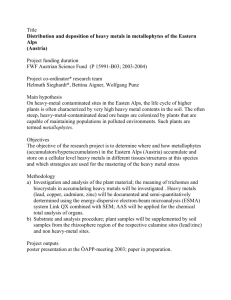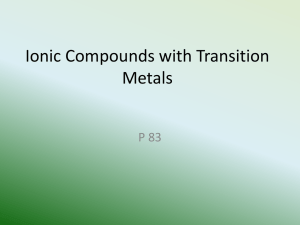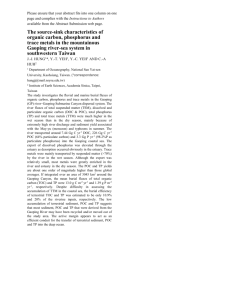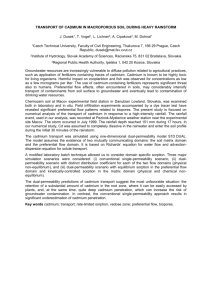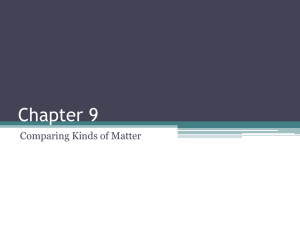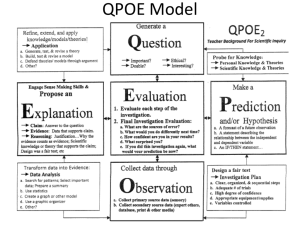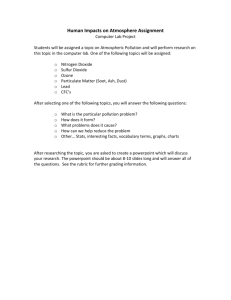Title:- Airborne inhalable metals in Commercial, Residential and
advertisement
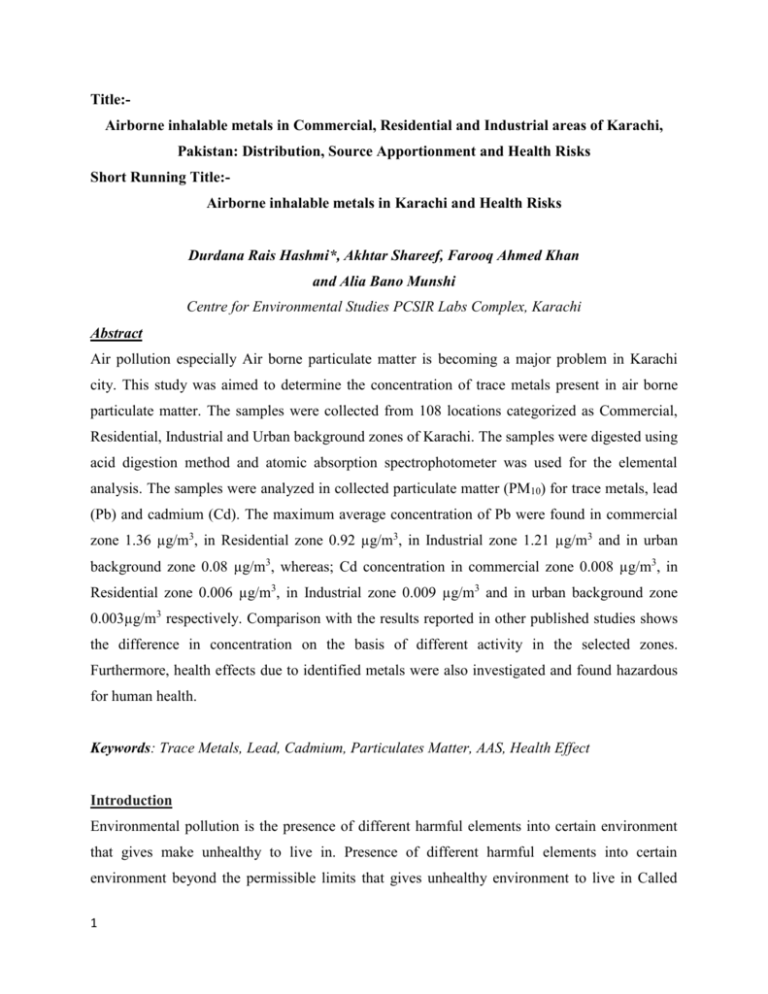
Title:Airborne inhalable metals in Commercial, Residential and Industrial areas of Karachi, Pakistan: Distribution, Source Apportionment and Health Risks Short Running Title:Airborne inhalable metals in Karachi and Health Risks Durdana Rais Hashmi*, Akhtar Shareef, Farooq Ahmed Khan and Alia Bano Munshi Centre for Environmental Studies PCSIR Labs Complex, Karachi Abstract Air pollution especially Air borne particulate matter is becoming a major problem in Karachi city. This study was aimed to determine the concentration of trace metals present in air borne particulate matter. The samples were collected from 108 locations categorized as Commercial, Residential, Industrial and Urban background zones of Karachi. The samples were digested using acid digestion method and atomic absorption spectrophotometer was used for the elemental analysis. The samples were analyzed in collected particulate matter (PM10) for trace metals, lead (Pb) and cadmium (Cd). The maximum average concentration of Pb were found in commercial zone 1.36 µg/m3, in Residential zone 0.92 µg/m3, in Industrial zone 1.21 µg/m3 and in urban background zone 0.08 µg/m3, whereas; Cd concentration in commercial zone 0.008 µg/m3, in Residential zone 0.006 µg/m3, in Industrial zone 0.009 µg/m3 and in urban background zone 0.003µg/m3 respectively. Comparison with the results reported in other published studies shows the difference in concentration on the basis of different activity in the selected zones. Furthermore, health effects due to identified metals were also investigated and found hazardous for human health. Keywords: Trace Metals, Lead, Cadmium, Particulates Matter, AAS, Health Effect Introduction Environmental pollution is the presence of different harmful elements into certain environment that gives make unhealthy to live in. Presence of different harmful elements into certain environment beyond the permissible limits that gives unhealthy environment to live in Called 1 pollutants e.g., Cd, Pb, Zn, Cu, Ni and Mn. These elements are released into the atmospheric air from different natural and anthropogenic activities. High rate of urbanization, unplanned industrial development, traffic congestion, indiscriminate use of pesticides and fertilizers are the main factor responsible for trace metal pollution in ambient air environment. Periodic table consisting of hundred and ten elements from which twenty two have been act as normal constituents of biological tissues. While only 0.4% contributes as trace metals and found as toxic or poisonous metals even at low concentrations (Duruibe, J.O., et al., 2007). However, it is generally known that continuous ingestion of toxic metals even in low doses, lead to adverse health effects and cause permanent damage on human health. Trace metal concentration in particulate matter of air helps to evaluate the degree of atmospheric pollution and health hazards to human population. The population in urban areas highly exposed to the aerosol toxic metals. Several researches on atmospheric metal concentration and their associated health hazards have been conducted in different parts of the world showing various fluctuations and disparities in trace metal constituents. All these metals produce different diseases like Lead and Cadmium causes slowing of heart rate, leukemia and different types of cancer (Shahid A. T et al, 2013). Due to the lack of appropriate air quality management capabilities, the Pakistan is suffering from deterioration of air quality. Evidence from various governmental organizations and international agencies has indicated that air pollution is a significant risk to the environment, quality of life and human health. Atmospheric aerosol particles are solid or liquid particles suspended in air. Processes that, control formation, transformation and the removal of atmospheric aerosols is of great interest in atmospheric science. Atmospheric particles show an imported role in atmospheric air. It may persuade the visibility, environmental conditions and health hazards. In the atmospheric air, presence of particulate matter, toxic metals and some other organic pollutants are considered as priority pollutants by World Health Organization (WHO, 2000). 2 The rapid unplanned industrialization, high rate of urbanization, traffic congestion and haphazard’s use of pesticides in agriculture increases the level of toxic metals in the atmospheric air. Emissions from the fossil fuel combustion, solid waste incineration, stacks of industries, vehicular emissions and other human activities are chief sources of toxic metals metals, in urban environment. Toxic metals produce hazardous effects on human health. Toxic metals like lead and cadmium are toxic even at low levels (Itoh et al, 2006; Kalantari , 2008 and Vinodhini & Narayanan, 2009]). In recent years, most of the researches have focused on the concentration, distribution and identification of toxic metals in the atmospheric particulate matter. Several researches on soil, water and plants in Karachi city have detected high concentration of toxic metals in the environment. It has been estimated that urban air pollution causes ˜360 000 premature deaths each year in Asia while an estimated 10 500 premature deaths occur per year in Delhi, India, due to toxic metal pollution (Gurjar et al., 2010). During last two decades, significance of this research lies in the risk pollutants and their impact on the public health (Chirenje, T. et al.,2006, Inyang, H.I. and S. Bae, 2006). Exposure to toxic metals in the atmospheric air can occur by means of ingestion, inhalation and dermal contact. The adverse health effects of toxic metals in the atmosphere include respiratory infections, asthma, premature deaths, cardiovascular diseases and risk of the cancer (Sicard.P, et al, 2011). In Pakistan, air quality deteriorating continuously because the lack of air quality management capabilities Indication about a significant risk to the environment, quality of life and human health have been shown from various governmental organizations and international agencies (Mavroidis I, Chaloulakou A; 2010). The aim of present study was to investigate the concentration of trace metals (Pb, and Cd) at different selected areas in Karachi city. These results were also compared with other similar 3 studies quoted in national and international journals having impact factors. It is hoped that this study will be very useful towards the future environmental study programs. Materials and Methods Sampling One hundred eight locations were selected for sample collection on the main roads, side road, round about, and open places along the busy roads of Karachi (Figure - 1), and these locations were categorized as commercial, residential, Industrial and urban Background zones of the Karachi’s environment. Samples were collected using high volume air sampler for a period of 24 hrs (1440 min) with an average flow rate of 1.0 m3/min. Samples on glass fiber filters were collected with the collection efficiency of 95 %. Then using oxidizing acid mixture, wet digestion of samples was performed and the digested samples were then analyzed by AAS for trace elements Pb and Cd respectively. Figure 1: Location map 4 Reagents All the experiments were performed with analytical reagent grade chemicals. All the glassware were extensively soaked with diluted HNO3 and rinsed twice with distilled water. The reagents were ultra pure or analytical (A.R) grade and diluted by distilled and de-ionized water. Reference standards were prepared from ACCU (Traceability of these standards to National Institute of Standards and Technology) standard (1000 mg/lit). Sample Preparation: Particulate matter Samples were collected on glass fiber filters. The digested samples were dissolved in an acid mixture containing 10 ml of 65% HNO3 and 4 ml of 60% HClO4. Organic matters were decomposed and metal ions were changed into their respective nitrates. The mixture is then filtered through No.42 Whatman filter paper into a volumetric flask and made up to the mark by adding de-ionized water. Apparatus Analysis was performed on AAS (Hitachi Z- 8000), with Zeeman Effect background correction. The Spectrophotometer is outfitted with a graphite furnace, a microprocessor and a built in printer. Determination of trace metals (Pb & Cd) was carried out by Electro-thermal Atomic Absorption Spectrometry (ETAAS) on AAS, employing the standard addition technique. Measurement was made by using the hollow cathode lamp for the metals Pb and Cd respectively. Analysis of Soil Samples Sample of particulate matter analyzed for Pb and Cd with elector-thermal ETAAS. Triplicate readings were taken on each sample by AAS, and the mean values of these readings were used to calculate results. The working conditions for detected elements by AAS are presented in Table 1. Table – 1 : Working Condition for Detected Elements by Atomic Absorption Spectrophotometer. Parameters Slit (nm) Wave length (nm) Drying temperature (°C) Ashing Temperature (°C) Atomization Temperature (°C) 5 Pb 1.3 283.3 80 - 120 400 2000 Cd 1.3 228.8 80 - 120 300 1500 Results and Discussion One hundred eight (54+36+14+4) samples of particulate matter were collected from the main roads, side road, round about, and open places along the busy roads of Karachi (Figure 1), and these locations were categorized as commercial (54 locations), residential (36 locations), Industrial (14 locations) and urban Background zones (04 locations) of the Karachi city. Analysis of these particulate matter samples were carried out for Lead and Cadmium respectively, by using Atomic Absorption Spectroscopy (AAS) employing standard addition method. The average concentration of Lead and Cadmium for commercial (54 locations), residential (36 locations), Industrial (14 locations) and urban Background zones (04 locations) are presented in Figure 2, 3, 4 and 5. The level of investigated Lead and Cadmium in particulate matter (PM10) samples was found in µg/m3. Figure-2-5 shows the average concentration of lead and cadmium in commercial, residential, Industrial and urban Background areas of Karachi city during the year of 2009-2011. Figure-2 shows the concentration of lead and cadmium at 54 locations in Commercial areas of Karachi. Maximum average concentration of lead and cadmium found at location C-46 (3.5 µg/m3 Pb) and (0.019 µg/m3 Cd) respectively. The high concentration of lead and cadmium may be due to the large parking place for hundreds of vehicles near this round about with very high traffic density. Moreover; the roads are narrow and congested with high traffic density. The lowest concentration of lead and cadmium in commercial areas was found at location C-6 (0.21 µg/m3 Pb) and (0.002 µg/m3Cd) respectively. The low concentration at this location may be because this is an open place on wide road having low traffic density with low emissions. All the sampling points in commercial areas were on the busiest intersections in Karachi and are surrounded by multistoried buildings both for commercial offices and residential buildings on main roads and round about having high traffic density. 6 Figure – 2 Concentration of Trace Metals (Pb and Cd) in Commercial Areas of Karachi city Figure 3 shows the concentration of lead and cadmium at 36 locations in residential areas of Karachi. Maximum concentration of lead and cadmium found at location R-31 (3.1 µg/m3 Pb) and (0.024µg/m3 Cd) respectively. The factors responsible for high values at R-31 are multistoried buildings located at both side of the roads which produce tunnel effect in this area and high traffic density, whereas, the lowest concentration of lead and cadmium found at location R-3 (0.27µg/m3 Pb) and (0.002 µg/m3 Cd) respectively due to open place with low vehicular emissions. Residential areas covered with densely populated areas having high traffic density. The sampling points in residential areas are also covered with the busiest intersections in Karachi and surrounded by single and mostly multistoried buildings for residence. The populations living around the selected locations were middle and high income group and also have high emission of vehicles. 7 Figure -3 Concentration of Trace Metals (Pb and Cd) in Residential Areas of Karachi city Figure 4 shows the concentration of lead and cadmium at 14 locations in industrial areas of Karachi. Maximum concentration of lead and cadmium found at location I-14 (2.34 µg/m3 Pb) and (0.020 µg/m3 Cd) respectively. Increase in trace metal pollution at this location may be due to high traffic density and emission from the industries which are located on main roads of the city. Whereas; lowest concentrations of lead and cadmium found at location 1-2 (0.17 µg/m3 Pb) and (0.002 µg/m3 Cd) respectively, the low values found here may be because these industrial areas has relatively open place and situated on the intersection of very wide road. The sampling points in industrial areas having different types of industries. The areas covered SITE, LITE, KIA and Port Qasim. Approximately 60 percent of the industries are textile mills, while other involve pharmaceuticals, chemicals, detergents, iron and steel, Sulphur refining, vegetable oil, beverages and food products. 8 Figure -4 Concentration of Trace Metals (Pb and Cd) in Industrial Areas of Karachi city Figure 5 shows lead and cadmium concentration at 04 locations in background areas of Karachi. Maximum concentration lead and cadmium in urban background areas was found at location Ub-2 (0.12 µg/m3 Pb) and (0.005µg/m3 Cd), whereas minimum concentration was found at location u-b-4 (0.06 µg/m3 Pb) and (0.002µg/m3 Cd) respectively. The low values found here may because the locations selected in urban background areas are relatively open places and situated on wide roads having low traffic density. The sampling points ub-2 and ub-3 in Urban background areas are 390 Km away from the main super highway whereas ub-1 and ub-4 are situated on wide road. The areas around the sampling site are sparsely populated having low vehicular traffic. 9 Figure - 5 Concentration of Trace Metals (Pb and Cd) in Urban Background Areas of Karachi city Lead has been found to be one of the major toxic elements generated through the motor vehicle exhaust using leaded gasoline. It is non degraded pollutant and it not only accumulate in the body but also modifies itself as it moves through biological cycles and food chain. The relatively high lead concentration in Karachi could predominantly originate from burning of solid waste and from large number of vehicles. Emission from road or wind-blown dust, or other industries may also have significant contribution to the lead pollution in Karachi city. Previously, much attention has been paid towards lead in the atmosphere due to wide spreads use as an antiknocking agent in gasoline (Jones, B. J., 1991). Presently, however, after the introduction of the regulations requiring the reduction in the lead content in gasoline markedly decreased from 0.64 g/lit in 1966 to 0.14 g/lit in 1986, this decrease of lead concentration in gasoline also decrease the addition of lead to the environment by using in the motor vehicles. Whereas, previously deposited lead concentration in the environment is a main source of lead in present environment. 10 Even though the concentration of lead decreases in the gasoline but due to increase of vehicles in the city also increase the emission of lead in the environment of the city. The average concentration of cadmium at some points exceeded the WHO guidelines value (0.005 µg/m3) in commercial and industrial areas at selected points in Karachi. The higher cadmium concentration in industrial areas of Karachi may be due to the release of cadmium from different industrial and mechanical process. Whereas in commercial areas may be due to the vehicular traffic. The sources of cadmium are diesel and lubricating motor oil, tyres and galvanized part of the vehicles. Diesel oil contains 0.07 to 0.1 ppm of Cd, whereas lubricating oil contains 0.26 ppm. The wear and tear of automobile tyres, which contain 20 – 90 ppm Cd, is main source of Cd pollution (I.H Qureshi, 2000). However the cadmium concentration has the lowest concentration than the measured concentration of lead in this study. Care should be taken about the sources and remedy of the high level of cadmium pollution in Karachi as it has serious impact on human health. Table 2. Comparison of metal concentrations (µg m3) with other parts of the world Location /Site type Typography Cd Pb Reference Commercial 0.008 1.36 Residential 0.006 0.92 Karachi, Pakistan Present Study Industrial 0.009 1.21 U-background 0.003 0.08 background Residential Delhi, India, 0.01-0.02 0.27-0.46 Khillare and Sarkar, (2012) [15] Residential Coimbatore, India BDL 0.21-0.62 Vijayanand et al., (2008) [16] Urban Agra, India NR 1.1 Kulshrestha et al., (2009) [17] Urban Delhi,lndia 0.01 0.44 Shridhar et al., (2010) [18] Urban Lahore, Pakistan 0.08 4.4 von Schneidemesser et al., (2010) [19] Residential Beijing, China 0.005 0.33 Khan et al., (2010) [20] Residential Tocopilla, Chile NR 0.01 Jorquera, (2009)a [21] Urban Istanbul, Turkey 0.001 0.07 Theodosi et al., (2010) [22] Lecce, ltaly Urban background NR 0.008 Contini et al., (2010) [23] Urban Vienna, Austria 0.0005 0.01 Limbeck et al., (2009) [24] Bratislava, Urban 0.0001 0.02 Meresova et al., (2008) [25] Slovakia Urban Huelva, Spain 0.0006 0.02 Sanchez de la Campa et al., (2007) [26] Edinburgh, UK Urban background 0.0003 0.01 Heal et al., (2005)b [27] Urban Los Angeles, USA NR 0.002 Singh et al., (2002) [28] NR: not reported; BDL: below detection limit, a: sampling in March-April 2006, b: median values 11 Table -2 show that various studies on Trace metals (lead and cadmium) level in PM10 samples have been undertaken in different countries of the world. Khillare and Sarkar (Khillare and Sarkar; 2012) reported the Pb concentration in particulate matter in urban residential areas within the range 0.27 to 0.46 µg/m3. In the present study (table1) average concentration of lead in residential areas was recorded 0.92 µg/m3 which is higher from Delhi, India (Shridhar et al; 2010), Coimbatore, India (Vijayanand et al., 2008), Beijing China (Khan et al; 2010) and Tocopilla, Chile (Jorquera; 2009), in urban background areas was recorded as 0.08 µg/m3, which is higher than that reported for urban background of Italy (Contini et al., 2010) and UK (Heal et al; 2005). Level of lead and cadmium also analyzed in the samples collected from industrial and commercial areas of Karachi city. The average concentration of lead in industrial areas was found to be 1.21 µg/m3 whereas in commercial areas of Karachi was found to be 1.36 µg/m3 respectively. Khillare and Sarkar (Khillare and Sarkar; 2012) also reported the concentration of cadmium in particulate matter range from 0.01 to 0.02 µg/m3. Table 1 shows that, in the present study the average concentration of Cd in residential areas was recorded as 0.006 µg/m3 which is higher from Delhi, India (Shridhar et al; 2010), Coimbatore, India (Vijayanand et al., 2008), Beijing China(Khan et al; 2010) and Tocopilla, Chile (Jorquera; 2009), in urban background areas was recorded as 0.003 µg/m3 which is higher than that reported for urban background of Italy (Contini et al., 2010) and UK (Heal et al; 2005), in industrial areas was found to be 0.009 µg/m3 whereas in commercial areas of Karachi was found to be 0.008 µg/m3 respectively. Table 3. Comparison of metal concentrations (µg m3) with USEPA and WHO guidelines Pb Cd Commercial (present study) µg/m3 1.36 0.008 Residential (present study) µg/m3 0.92 0.006 Industrial (present study) µg/m3 1.21 0.009 U-background (present study) µg/m3 0.08 0.003 WHO µg/m3 0.500 0.005 USEPA µg/m3 1.500 0.006 In the atmospheric air toxic metals cannot be destroyed or shattered, and can be inhaled during breathing. Various studies on atmospheric metal concentration and their health hazards have been carried out in different cities of the world which shows variations in the concentration of toxic elements like Lead and Cadmium (Freitas MC, et al; 2004). Both these toxic metals causes 12 different types of health hazards as slowing of heart rate, different types of cancer, Bronchitis and leukemia (Khillare and Sarkar; 2012 and Jorquera; 2009). As lead is one of the well known man made environmental pollutant and causes chronic obstructive pulmonary diseases, lungs cancer, bronchitis and chief source of asthma both in young and older citizens. Even a very small amount of lead exposure becomes physiologically active and results into its accumulation in the food chain. Adverse health effects on humans particularly on infant Central Nervous System (CNS) have been well established. Cadmium is carcinogen to human body, inhalation of Cd, causing lung cancer, different types of cardio-vascular diseases acute and chronic kidney diseases. Other effects due to cadmium exposure due to breathing for a long time are lung damage and fragile bones (Järup L, Alfvén T; 2004). In this study health risk by trace metals such as Pb and Cd were also investigated in the collected samples of particulate matter. These investigated trace metals were found to be toxic at elevated level and causing serious health hazards such as pulmonary diseases, cardiovascular diseases, heart attacks, lungs infection, kidney diseases, loss of appetite, abdominal pain, dirrohea, vomiting, blood pressure, constipation, paralysis and eye irritation respectively. The following steps have been taken in this study. Data has been collected by the ‘Questionnaire method’ covering various aspects of environment like socio -economic status, outdoor air pollution, vehicular pollution, industrial pollution, sanitation, quality of drinking water and diseases like respiratory, gastrointestinal, eye diseases, skin problems, water/vector borne diseases, cancer, cardiovascular and miscellaneous ones have been taken into consideration. Initially a draft questionnaire was developed on issues such as socio-economic background of the respondents about the health hazards of particulate air pollution (PAP). Questionnaires has been filled from 350 respondents (150 from commercial, 76 from residential, 100 from industrial and 24 from urban background areas) about their health status. 13 Percentages of the effectes were also calculated during the study. Figure 6 a, b, c and d shows the % of health related diseases in selected areas as Commercial, residential, industrial and urban background areas of Karachi. 14 Figure 6 a,b,c and d: Area Wise Percentage Health Hazards Related to Karachi’s Environment. Figure 7 shows the overall % of health related diseases in in the environment of Karachi city. The collected data from questionnaires filled by 350 respondents show that 11% had developed cancer, 8.01% fatigue, 18.0% respiratory diseases, 7% skin disease, 10% headache, 16% heart attack, 9% eye irritation, 7% allergy and 14% Asthma respectively in the concerned areas. 15 Figure 7: Overall average % age of health hazard related to total environment of Karachi. Result of this study shows that average health situation has close linkage with particulate matter path ways and population. The infants, elders, and the persons who suffer with chronic cardiopulmonary diseases, influenza or asthma are at the risk of mortality and serious morbidity effects while others are vulnerable to less serious health effects such as increase in respiratory diseases, decreased lung function or physiological changes. Conclusion Toxic trace metal contamination in urban areas of Karachi shows that growing number of vehicles, leaded gasoline consumption and poor conditions of the roads are major cause of high concentration of lead and other trace metals level in the environment of Karachi. High concentrations of trace metals in atmospheric particulate matters are a great threat for the public health in Karachi, Pakistan. Therefore, it is very important to determine the concentration levels of trace metals as per WHO guidelines. Lead and cadmium in particulate matter sample were measured in Karachi city. The average cadmium concentration was slightly higher but very close to the WHO guideline value. The lead 16 concentration was below the USEPA values and slightly higher than WHO guideline value and also showing decreasing tendency as compared to the previous measurements in Karachi. The results from this study may be useful for assisting with calculating the planning and regulation. A valuable control policy should be developed and implementation should be carried out to avoid the trace metals in particulate pollution which is a major problem in the city. References:1. Chirenje, T., L.Q. Ma and L.P. Lu, 2006. Retention of Cd, Cu, Pb and Zn by wood ash, lime and fume dust. Water Air Soil Pollut., 171, 301-314. 2. Contini, D., Genga, A., Cesari, D., Siciliano, M., Donateo, A., Bove, M.C., Guascito, M.R. 2010. Characterisation and source apportionment of PMlO in an urban background site in Lecce. Atmospheric Research , 95, 40-54. 3. Duruibe, J.O., M.O.C. Ogwuegbu and J.N. Egwurugwu, 2007. Heavy metal pollution and human biotoxic effects. Int. J. Phys. Sci., 2, 112-118. 4. Freitas MC, Pacheco AMG, Verburg TG, Wolterbeek HT. 2010. Effect of particulate matter, atmospheric gases, temperature, humidity on respiratory and circulatory diseases' trends in Lisbon, Portugal. J. Environ Monitoring Ass; 162, 113- 121. 5. Gurjar. B.R, Jain. A, Sharma. A, Agarwal. A, Gupta.P, Nagpure.A.S, Lelieveld.J. 2010. Human health risks in megacities due to air pollution. Atmospheric Environment, 44, 4606-4613. 6. Heal, M.R., Hibbs, L.R., Agius, R.M., Beverland, L.J. 2005. Total and water soluble trace metal content of urban background PMlO, PM2.5 and black smoke in Edinburgh, UK. Atmospheric Environment, 39, 1417-1430. 7. Inyang, H.I. and S. Bae, 2006. Impacts of dust on environmental systems and human health. J. Hazard. Mater., 132, 5-6. 8. Itoh, Y., Miura, S., Yoshinaga, S. 2006. Atmospheric lead and cadmium deposition within forests in the Kanto district, JAPAN. J For. Res., 11: 137-142. 9. Järup L, Alfvén T. 2004. Low level cadmium exposure, renal and bone effects-the OSCAR study. Biometals,; 17, 505-509. 10. Jones, B. J., Symon, C., Tylor, P.K.L., Walsh, J., Johnston, A.E., 1991. Evidence for a decline in rural herbage lead levels in UK. J. Atmosphere and Environmental (A), 25, 361–369. 17 11. Jorquera, H. 2009. Source apportionment of PMlO and PM,.5 at Tocopilla, Chile (22°05'5, 70012'W). Environmental Monitoring and Assessment, 153, 235-251. 12. Kalantari, N., and Ghaffari, S., 2008. Evaluation of toxicity of heavy metals for Escherichia Coli growth . Iran. J. Environ. Health. Sci. Eng, 5: 173-178. 13. Khan, M.F., Hirano, K., Masunaga. 2010. Quantifying the sources of hazardous elements of suspended particulate matter aerosol collected in Yokohama, Japan. Atmospheric Environment 44, 2646-2657. 14. Kulshrestha, A., Satsangi, P.G., Masih, J., Taneja, A. 2009. Metal concentration of PM'.5 and PMlO particles and seasonal variations in urban and rural environment of Agra, India. Science of the Total Environment , 407, 6196-6204. 15. Limbeck, A., Handler, M., Puis, c., Zbiral, J., Bauer, H., Puxbaum, H. 2009. Impact of mineral components and selected trace metals on ambient PMlO concentrations. Atmospheric Environment, 43, 530-538. 16. Mavroidis I, Chaloulakou A. 2010. Characteristics and expected health implications of annual PM10 concentrations in Athens, Greece. Int J Environ Pol; 411-2: 124-139. 17. Meresova, J., Florek, M., Holy, K., Jeskovsky, M., Sykora, I., Frontasyeva, M.V., Pavlov, 5.5., Bujdos, M. 2008. Evaluation of elemental content in air-borne particulate matter in low-level atmosphere of Bratislava. Atmospheric Environment, 42, 8079-8085. 18. Pandit s. Khillare, Sayantan Sarkar, 2012. Airborne inhalable metals in residential areas of Delhi, India: distribution, source apportionment and health risks, Atmospheric Pollution Research. 3; 46-54. 19. Qureshi. I.H, Proceding Pakistan Academy of science, 2000. 37: 109. 20. Sanchez de la Campa, A.M., de la Rosa, L, Querol, X., Alastuey, A., Mantilla, E. 2007. Geochemistry and origin of PMlO in the Huelva region, Southwestern Spain. Environmental Research, 103, 305-316. 21. Shahid M. A *, Khadim H, Ahmad R, 2013. Levels of Trace Metals in the atmosphere of Faisalabad and human health risk assessment, Int. J of Envi Sci, Tech and Envi Res, 1, 1-16. 22. Shridhar, V., Khillare, p.s., Agarwal, T., Ray, S. 2010. Metallic species in ambient particulate matter at rural and urban location of Delhi. Journal of Hazardous Materials 175, 600-607. 18 23. Sicard, P., Lesne, O., Alexandre, N., Mangin, A., Collomp, R. 2011. Air Quality Trends and Potential Health Effects - Development of an Aggregate Risk Index. Atmos. Environ, 45, 1145-1153. 24. Singh, M., Jaques, P.A., Sioutas, C. 2002. Size distribution and diurnal characteristics of particle-bound metals in source and receptor sites of the Los Angeles basin. Atmospheric Environment, 36, 1675-1689. 25. Theodosi, C., 1m, U., Bougiatioti, A., Zarmpas, P., Yenigun, 0., Mihalopoulos, N. 2010. Aerosol chemical composition over Istanbul. Science of the Total Environment, 408, 2482-2491. 26. Vijayanand, c., Rajaguru, R., Kalaiselvi, K., Selvam, K.P., Palanivel, M. 2008. Assessment of heavy metal contents in the ambient air of the Coimbatore city, Tamilnadu, India. Journal of Hazardous Materials 160, 548-553. 27. Vinodhini, R., and Narayanan, M., 2009. The impact of toxic heavy metals on the hematological parameters in common crap (Cyprinus Carpio L.) . Iran. J. Environ. Health. Sci. Eng., 6, 23-28. 28. Von Schneidemesser, E., Stone, LA., Quraishi, T.A., Shafer, M.M., Schauer, J.J. 2010. Toxic metals in the atmosphere in Lahore, Pakistan. Science of the Total Environment 408, 1640-1648. 29. WHO,. Guidelines for air quality. World Health Organization, Geneva. 2000. Retrieved from http://www.who.int/ environmentalinformation/Air/Guidelines/aqguide7. 19
